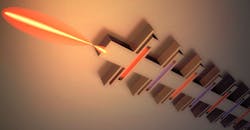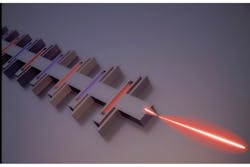Chip-Scale Laser Structure Nearly Doubles Terahertz Output Power
Terahertz (sub-millimeter) waves—wavelengths of 1 mm down to 30 µm, corresponding to frequencies from 300 GHz to 3 THz (1 THz = 1012 Hz)—pose a dilemma for practical use because they’re in the zone between the standard RF spectrum and optical world. While they offer potential for innovative applications such as subsurface inspection, explosive detection, and many others, it’s a technical challenge to generate and sense them.1
Nonetheless, the potential of terahertz waves in specific applications is enormous, so there’s effort devoted to improving their sources. In work funded by NASA, the National Science Foundation, and the U.S. Department of Energy, a team of researchers from MIT, Sandia National Laboratories, and the University of Toronto has developed an innovative physical structure that increases the power output of chip-mounted terahertz lasers by 80%, resulting in the best-performing chip-mounted terahertz source yet reported.
This isn’t just a laboratory prototype: It has been selected by NASA to provide needed emissions for the Galactic/Extragalactic ULDB Spectroscopic Terahertz Observatory (GUSTO) mission, targeted for a 2021 launch date.2,3 The goal of this mission is to determine the composition of the “interstellar medium,” and terahertz rays are especially well-suited to the spectroscopic measurement of oxygen concentrations. Weight is critical because the mission will be balloon-launched to the Earth’s upper atmosphere.
1. This artist’s rendition of the terahertz waveguide shows the slots and reflectors added outside the waveguide to redirect the terahertz wave energy. (Source: MIT)
The new approach is a variation on a third-order laser with distributed feedback, which is one of the best ways to generate a high-quality terahertz output beam. While an effective source, it naturally emits its radiation in two opposite directions, which obviously means a 50% loss of directed output power. Note that conventional lasers also have this attribute, but it’s easily remedied by putting a mirror over one end of the laser. For terahertz waves, though, a mirror would reflect only a tiny fraction of the wave’s total energy.
The new design redirects 80% of the light that usually exits out the back of the laser to the front, by exploiting an inherent aspect of the tiny laser’s design. A standard quantum cascade laser has a long rectangular ridge acting as a waveguide, and application of an electric field induces a standing electromagnetic wave along the length of the waveguide. The group then cut regularly spaced slits into the waveguide, which allow terahertz rays to radiate out (Fig. 1).
These slits are spaced so that the waves they emit reinforce each other only along the axis of the waveguide, while at more oblique angles from the waveguide, they cancel each other out. They then put reflectors behind each of the slits in the waveguide, a step that can be part of the manufacturing process of the waveguide itself.
2. Finite element simulation used to verify the design concept and performance before initial fabrication5 shows both real and dummy reflectors are made of vacuum (vacuum shown with red color) (a); dummy reflectors made of vacuum and reflectors made of GaAs (shown in blue) (b); and dummy reflectors switched with real reflectors (c). (Source: Nature/Macmillan Publishers Limited)
The reflectors are wider than the waveguide, and they’re spaced so that the radiation they reflect will reinforce the terahertz wave in one direction, but cancel it out in the other. Some of the terahertz-wave energy that lies outside the waveguide still makes it around the reflectors, but 80% of the energy that would have exited the waveguide in the wrong direction is now redirected the other way (Fig. 2).
As an added benefit, the new approach isn’t tied to any particular “gain medium,” the combination of materials used in the body of the laser. Ali Khalatpour, the MIT graduate student who is first author on the paper published in Nature Photonics,4,5 noted that “if we come up with a better gain medium, we can double its output power, too. We increased power without designing a new active medium, which is pretty hard.”
References
1. IEEE Spectrum, “The Truth About Terahertz.”
2. Jet Propulsion Laboratory, “NASA Selects Mission to Study Churning Chaos in Milky Way and Beyond.”
3. NASA, “GUSSTO!”
4. Nature Photonics, “Unidirectional photonic wire laser,” August 7, 2017.
5. Nature Photonics Supplemental Information, “Unidirectional photonic wire laser.”
About the Author

Bill Schweber
Contributing Editor
Bill Schweber is an electronics engineer who has written three textbooks on electronic communications systems, as well as hundreds of technical articles, opinion columns, and product features. In past roles, he worked as a technical website manager for multiple topic-specific sites for EE Times, as well as both the Executive Editor and Analog Editor at EDN.
At Analog Devices Inc., Bill was in marketing communications (public relations). As a result, he has been on both sides of the technical PR function, presenting company products, stories, and messages to the media and also as the recipient of these.
Prior to the MarCom role at Analog, Bill was associate editor of their respected technical journal and worked in their product marketing and applications engineering groups. Before those roles, he was at Instron Corp., doing hands-on analog- and power-circuit design and systems integration for materials-testing machine controls.
Bill has an MSEE (Univ. of Mass) and BSEE (Columbia Univ.), is a Registered Professional Engineer, and holds an Advanced Class amateur radio license. He has also planned, written, and presented online courses on a variety of engineering topics, including MOSFET basics, ADC selection, and driving LEDs.



